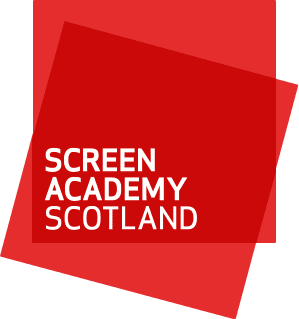As a visual artist with a background in web technologies as well as the Administration Manager at Screen Academy Scotland I was intrigued by the SICSA Playlab’s aim to:
… create playful interactive work in the space of a day… [with] artists and technologists who are willing to work together to make something to play with. Don’t worry, you’re in safe hands, we’ve done this before.
Though in a previous life I had built websites and managed tech projects I had trepidations about not being ‘techy’ enough. That dissipated somewhat when after arriving at the Barnes Building at GSA I met the delightful Tom and Julie who enthusiastically introduced our loosely structured ‘play day’. Our task was to experiment with the tableful of kit, including a 360 camera constructed of 6 go-pros connected in a helix shape, a samsung gear 360 camera, a small cardboard box to transform your phone into a VR headset, as well as tape, wire, midi boards, paper and glue, to create a pop-up exhibition for the panel discussion taking place at 6pm that evening.
Appropriately we went to nearby Garnethill Park to play with the kit, taking the opportunity to run, jump, hide and seek – all in a day’s Playlab! Taking the footage from the 360 cameras back to the Barnes, Tom set about the process of knitting together the 6 separate bits of footage from the 360 go-pro camera using Autopano Videopro software so that it could be outputted to a spherical interactive projector called the Pufferfish, a 60k piece of amazing kit which Julie had brought with her from Glasgow University. In the meantime, the footage from the Samsung Gear 360 went into projection mapping software Heavy M by artist Martin Sweeney to prepare it for the exhibition space outside the Barnes lecture theatre.
Once we were in the space with laptops, projectors and the amazing Pufferfish the pressure was on to create an exhibition which showed a bit of the potential of the different interactive tools we’d experimented with during the day. Augoustinos and Felix helped us to create pieces using touch-activated wire connected to midi boards, with which we were able to create a simple set up that initiated sounds when touched. One piece, taped to the wall, and the other, hung in a doorway, were activated when people passed through or touched them, playing the sounds of our day in the park. An interactive projection of Garnethill park was mapped to the space and also onto the impressive Pufferfish which sat at the centre of the room like a great eye – what a completely compulsive piece of technology it is! Despite last minute technical hitches – always the way (!) and thanks to Tom, Julie, Felix, Martin and Augoustinos the exhibition was installed just in time for the panel discussion and a well-deserved glass of wine!
The panel discussion in the Barnes Lecture Theatre was hosted by Professor Chris Speed from ECA and Edinburgh Napier’s Tom Flint and included presentations from GSA Lecturer in Interactive Design Paul McGuire and Dennis from art duo the Dennis and Debbie Club – who’s work VR art piece Neobrutes was on display at the Travelling Gallery parked nearby on Renfrew Street. A wide-ranging discussion followed the presentations about ongoing developments in 3D exhibition and content creation, VR and immersive live performance events.
Though we only had time to scratch the surface of these technologies the SICSA Playlab provided much food for thought for my own visual art practice as well as for my work at Screen Academy Scotland where supporting and developing future fillmmakers is so much a part of what we do. It was also fantastic to see old friends and meet new colleagues, which is hopefully the beginning of fruitful collaborations to come.
Increasingly relevant to both artists and commercial filmmakers, these new technologies are also firmly in the sites of UK funder The British Film Institute which coincidentally published its latest strategy document BFI2022, Supporting UK Film on the same day as the Playlab:
“Our aim is to inspire excellence across the range, depth and diversity of the moving image, in ways that pique and support creativity, can augment experience, enrich cultural context, and create contemporary relevance….We will support the continued experimentation, innovation and development of the art of the moving image, whether for the big or small screen, whether delivered in a linear or interactive form. We will introduce greater flexibility in our funding criteria to encourage innovation…”
Many thanks to SICSA and the Playlab team for a fantastic and informative day!
Image by Bev Hood
Editor’s Note:
Playlab at Glasgow School of Art was sponsored by the Scottish Informatics and Computer Science Alliance (SICSA). Part of the SICSA mini research theme of Playful and Public Interaction, the Playlab on November 30th was organised by the leaders of the Research Theme Dr Julie R. Williamson, Glasgow University, Professor Chris Speed, Edinburgh College of Art and Dr Tom Flint, Edinburgh Napier University. Also on hand were Edinburgh Napier Lecturer Augoustinos Tsiros and Senior Computing Support Technician Felix Jarvis as well as a handful of artists from ECA, Edinburgh Napier and GSA including Bev Hood, Martin Sweeney, Mani Motta, Daphne Potamiti and myself.
SICSA Playlab: https://www.eventbrite.com/e/sicsa-playlab-day-and-night-30th-november-tickets-29044575106#
About SICSA http://www.sicsa.ac.uk/about-us/
New Media Scotland http://www.mediascot.org/about
The Travelling Gallery http://www.travellinggallery.com/
Dennis and Debbie Club http://dennisanddebbie.club/
Michele Marcoux www.michelemarcoux.com
Bev Hood http://www.bhood.co.uk/
Martin Sweeney http://www.unstablecreations.com/



